Faitheist How An Atheist Found Common Ground With The Religious by Chris Stedman by Chris Stedman

Author:Chris Stedman [Stedman, Chris]
Format: epub
Publisher: Beacon Press
Published: 2020-10-25T16:00:00+00:00
With my El Salvador trip finished, I set to finishing my degree.
Augsburgâs philosophy is that education does not just take place in the classroom, and students are required to participate in off-campus community service work in their first semester. I volunteered with an organization called the Campus Kitchen at Augsburg College, a satellite of the national Campus Kitchen Project. CKAC recovered unused food from the campus cafeteria and distributed it to hunger-relief agencies in the area. I became enamored with the work of CKAC in my first semester at Augsburg and looked for opportunities to move into leadership; when a slot opened up on the Leadership Team, I was thrilled to be invited. I requested the chance to lead the volunteer shift Iâd been trained on, a weekly visit to deliver food to the Brian Coyle Community Center.
Just blocks from school, BCCC served the Cedar-Riverside neighborhood, the most densely populated area of Minnesota, with nearly two thousand apartment units in a two-block area. Cedar-Riverside is home to Riverside Plaza, immortalized as the building in the opening sequence of The Mary Tyler Moore Show. Designed to be a utopian complex accommodating people from the highest of incomes to the lowest, today it primarily consists of subsidized housing. Numerous students at my school (who mostly refused to leave campus in anything but a car with locked doors for fear of being âshankedâ) not-so-lovingly referred to Riverside Plaza as âThe Crack Stacksâ and âThe Slum in the Sky.â (Those same individuals, most of whom had cars on campus, would go a few extra miles to avoid the closest Target, which they dubbed âTarghetto.â)
I was embarrassed by how many of my classmates wrote off an entire group of people. Yes, there was significantly more violent crime in that area than in other parts of Minneapolis, and it was important to be careful there. Crime is a reality in Cedar-Riverside, and that isnât changing: a year after I graduated and stopped volunteering there, an Augsburg student volunteer was shot and killed leaving BCCC. Still, I rarely felt uncomfortable walking or biking through Cedar-Riverside. There were times when I felt slightly unsafe and quickened my pace, but those times were few. The reason I was never the victim of such violence may have been pure and random luck, but I also believe that the fears many had about the neighborhood were overblownâif they had gotten to know more of the communityâs residents, they mightâve thought differently.
This idea that relationality has a transformative impact was one reason I so enjoyed working at BCCC. I wasnât just interested in dropping off some food once a week and patting myself on the back for doing my part. I wanted relationships with the people who frequented BCCC, to invite them to share their stories and to share my own. It was less about my coming in to âdo something niceâ and more about mutually enriching relationships between those serving and those being served. Service work should never be a one-way
Download
This site does not store any files on its server. We only index and link to content provided by other sites. Please contact the content providers to delete copyright contents if any and email us, we'll remove relevant links or contents immediately.
Never by Ken Follett(2880)
The Man Who Died Twice by Richard Osman(2298)
Machine Learning at Scale with H2O by Gregory Keys | David Whiting(2290)
Fairy Tale by Stephen King(2069)
Will by Will Smith(2041)
Reminders of Him: A Novel by Colleen Hoover(1879)
The Dawn of Everything: A New History of Humanity by David Graeber & David Wengrow(1570)
The Stranger in the Lifeboat by Mitch Albom(1532)
The Becoming by Nora Roberts(1330)
Friends, Lovers, and the Big Terrible Thing by Matthew Perry(1327)
New Morning Mercies: A Daily Gospel Devotional by Paul David Tripp(1321)
A Short History of War by Jeremy Black(1300)
HBR's 10 Must Reads 2022 by Harvard Business Review(1256)
The Strength In Our Scars by Bianca Sparacino(1244)
The Fall of Babel by Josiah Bancroft(1235)
Go Tell the Bees That I Am Gone by Diana Gabaldon(1234)
Can't Hurt Me: Master Your Mind and Defy the Odds - Clean Edition by David Goggins(1227)
515945210 by Unknown(1207)
Love on the Brain by Ali Hazelwood(1095)
